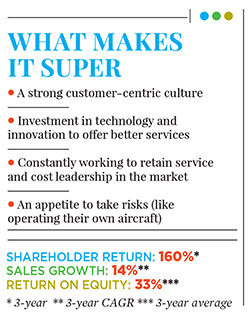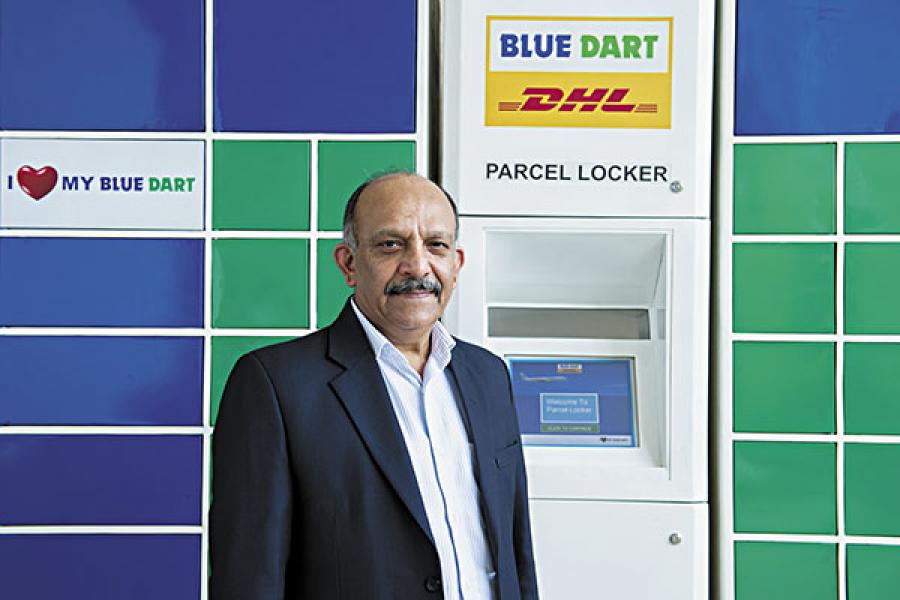
Blue Dart: Providing customer satisfaction @express speed
By putting customers first, Blue Dart has turned itself into the largest express courier company in South Asia
In 1993, over 300 managers of Blue Dart Express gathered in Mumbai for an offsite. The company had just completed 10 years of operations, but more than celebrating the milestone, the management was keen on charting the way forward. Those were exciting times. India had begun to open up its economy and that presented both opportunities as well as challenges for any business.
The two-day deliberation was intense and threw up a clear strategic vision: Blue Dart should become the leader in the domestic express courier market. (Bulk of its Rs 100 crore revenue till then came from international express shipments.)
But implementing it was easier said than done. Recalls Anil Khanna, managing director of Blue Dart Express and a 24-year company veteran, “there was no space in the sky”. Those days, the air express cargo was entirely carried by commercial airlines and the capacity was limited to the number of flights Indian Airlines operated (Jet Airways had just begun operations in 1993). “It was then we decided that we’ll buy our own aircraft,” says Khanna.
It was a far-reaching and risky decision. No other logistics player owned or operated an aircraft in India then. “When we acquired three Boeing 737 aircraft from Indian Airlines in 1996, it cost us Rs 30 crore. Our profit that year was around Rs 3 crore,” says Yogesh Dhingra, CFO & COO of the company. The promoters invested 10 times the annual profit on aircraft without knowing whether they would be used to full capacity (15 tonne each). “We were sure the model would work,” says Dhingra. It did, and the decision to operate an aircraft turned out to be a momentous one.
Today Blue Dart is the largest express courier company in South Asia. It has a 46 percent market share in the Rs 3,360 crore organised air express segment in India and a 13 percent market share in the Rs 4,830 crore ground express market. Its fleet of six Boeing 757 freighters gives it a formidable competitive advantage. The aircraft are supported by 9,212 ground vehicles operating across 13 domestic hubs serving 34,705 locations (including 21,091 pincodes). A zero debt company, Blue Dart has registered revenues of Rs 2,553 crore in 2015-16 and posted a net profit of Rs 193 crore. “Blue Dart is well poised to ride the next growth wave,” said ICICI Securities in its latest research report dated April 21, 2016.
Blue Dart was founded in 1983 by three youngsters—Khushroo Dubash, Clyde Cooper and Tushar Jani—in their late 20s, with an investment of Rs 30,000. The trio operated from a one-room office in Mumbai’s Nariman Point and aspired to create a world class company. Their resources were limited, so they banked on their soft skills: Right from the beginning, Blue Dart put customers at the core of the company’s operations.
That culture has continued even after Deutsche Post-DHL, the world’s largest logistics group with 59 billion euro in revenue, acquired 81 percent stake in the company in 2005. “Blue Dart is insanely customer-centric,” says Charles Brewer, CEO, DHL eCommerce, who oversees Blue Dart’s operations for the German logistics major. “They have got the product strategy right and are focussed on execution.” Says Khanna, “Almost all our products have their origins from the customers.” He spends considerable time meeting customers and the sales team’s performance (captured by the company’s sales management system) is appraised on this basis. Even Brewer, on a four-day visit to India in end-June, chose not to meet government officials or hold a town hall for employees, but visited some of Blue Dart’s key customers, such as Snapdeal, Amazon India, Xiaomi, Apple, Flipkart and the Tata group.
It was in one such customer meeting in 2008-09 that Khanna realised that the cash on delivery (CoD) mode of payment was a major pain point for ecommerce players. Guthy-Renker, a Santa Monica-based direct marketing company selling consumer products, had incurred a loss of Rs 3 crore on account of leakages in the transfer of money collected through CoD. “We saw an opportunity there,” he says.

The success of this premium product offering (Blue Dart charges 20 to 30 percent more than the industry) can be gauged by the fact that the company’s business-to-consumer segment (etail logistics) grew from almost nothing in 2008 to 25 percent of its overall revenue today. “The company has attuned its strategy and products according to the requirements of the [ecommerce] sector,” says ICICI Securities in its report.
Even the decision to operate dedicated aircraft stemmed partly from customer feedback. “Commercial airlines gave preference [they still do] to passenger baggage and often offloaded general goods when the cargo hold is full. This meant that we missed delivery schedules,” says Dhingra. “There were also complaints of mis-routing, damages and pilferage.” Today, Blue Dart offers time-bound products (Domestic Priority 1030 or Domestic Apex 1200).” By operating our own freighters at night we have been able to offer late cut-off for accepting parcels and ensuring early delivery next morning,” says Ketan Kulkarni, senior vice president, marketing.
Blue Dart has also adopted the ‘net promoter approach’—a tool to measure customer satisfaction and loyalty—to assess their own performance. Every month, customers are asked two simple questions on various touch points and a score is arrived at. “Our current score of 75 percent is very high among industry standards where even 50 percent is considered excellent,” says Khanna.
It is also this customer focus that propelled the company to use technology to deliver better service. It offered a track-and-trace facility even before other players in the industry had woken up to it. Blue Dart’s delivery boys were the first to have the now-ubiquitous handheld device on which the customer signs the receipt. It has also embedded numerous quality control and customer satisfaction measures with its various standard operating procedures needed for credit card deliveries. Each parcel is scanned 17 times to allow a customer to track his consignment at any given point in time. All the 9,212 vehicles are GPS-fitted and are tracked 24x7 at the Network Control Centre. An alert flashes the moment any vehicle on the road is off its schedule. If there are traffic issues, the vehicle is re-routed, and if there is a major delay, the customer is informed. “It is important the customer knows immediately,” says Dhingra. From August, the company will launch a feature by which a customer ordering a product from Flipkart or Amazon can track the entire last mile delivery on a map. To conduct such a procedure seamlessly, the company invests as much as $3 million every year on technology.
Blue Dart’s customer-centric policies are not merely cosmetic, but intrinsic. They begin by keeping the employees happy, the understanding being that happy employees translate into happy customers.
Way back in 1992, the company implemented an ‘employee satisfaction survey’ wherein all the employees were asked to rate the company on 62 different parameters such as relationship with superiors, fairness of the management, physical amenities etc. The mean satisfaction score in the latest round carried out in September 2015 was 4.71 out of 5, an overall satisfaction of 94.6 percent.
Blue Dart’s employees have not only ensured that the company scores high on the net promoter score but have come up with some critical innovations that have been adopted by DP-DHL worldwide and copied by competitors. One such innovation is the Fuel Surcharge Mechanism (to handle volatile swings in aviation fuel price) and the other is the Currency Adjustment Factor, which automatically takes into account fluctuations in currency values, and factors their impact into the bill. “Both these innovations helped us to weather sharp volatility in fuel prices or currency fluctuations. It is impossible to go to the customer every time seeking a price increase. This is a transparent mechanism and is fair to everyone,” says Dhingra.
Despite Blue Dart’s strong leadership position, Khanna is not taking it easy. There are challenges, he says. Attracting the right talent, he says, is one. The working environment is tough (on the road for long hours or handling shipments at night). The company has already applied for clearance from the Director General of Civil Aviation to fly drones for last-mile deliveries. “They are still in the process of framing rules and I expect a very restricted play here,” says Khanna.
The lack of landing slots at airports has meant that Blue Dart can operate its freighters only at night and that too for an average of six hours per day. That is far lower than the average 12 to 14 hours globally. “The team is working to see how best we can improve aircraft utilisation,” says Dhingra.
Besides, the road infrastructure in India is such that the average speed of a vehicle is just 30 km per hour, while in the developed world it is as high as 100 km per hour. The checkposts further add to the delay. “Between Delhi and Mumbai, there are 14 checkposts. Almost an hour is lost in every stop and results in the 1,400 km journey taking 42 hours instead of 14. There is potential to triple the productivity of our ground vehicles,” says Khanna. “Implementation of the GST will be a great facilitator as there will be no checkposts.”
The other big area that Blue Dart is working on is e-tailing. “We believe there is a real opportunity to write the ecommerce playbook,” says DHL’s Brewer. “The company that solves the last-mile delivery puzzle will get years of market leadership.” The puzzle that Brewer is referring to is a combination of the following factors: Predictability/visibility of delivery, choice of time, choice of place of delivery and payment options (CoD, credit card or payment wallet). According to KPMG, the Indian ecommerce market is estimated to grow from $17.6 billion in 2014 at a CAGR of 40 percent to touch $136 billion by 2020. Etailing is the second biggest component in it and is also the fastest growing. Some estimates put the size of etailing logistics at $900 million. Blue Dart’s CoD product has proved to be a key differentiator and the company has come up with a few more innovations. Locker facilities have been started in Delhi from where customers can collect their parcel/letters at their convenience. Parcel shops, where shipments can be delivered and picked up by customers later, as well as Sunday deliveries, are being experimented with.
DP-DHL’s Strategy 2020 vision focuses on ecommerce and emerging markets (it wants 30 percent of its revenues to come from the developing world from the present 22 percent). Blue Dart is critical on both parameters. Not surprising that Brewer, who came to India after 12 long years, is now planning to return every month.
(This story appears in the 05 August, 2016 issue of Forbes India. To visit our Archives, click here.)
-
 Neeraj Chopra
Neeraj ChopraReally impressive work shared with appropriate facts and figures on blue Dart. Keep up the good work team Forbes India . warm regards
on Aug 12, 2016 -
 Neeraj Chopra
Neeraj ChopraOutstanding reporting on blue Dart facts and figures . being a blue Darter myself I feel proud and Congratulate the Forbes India team for the inputs they have shared. Keep up the good work team Forbes India . warm regards NEERAJ CHOPRA
on Aug 12, 2016















